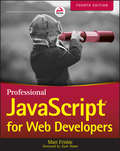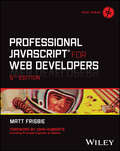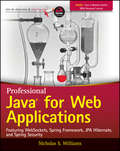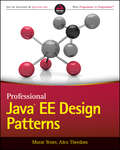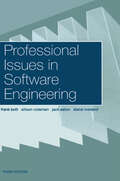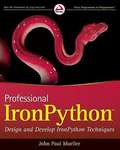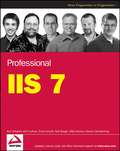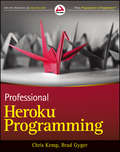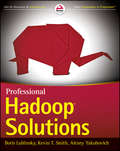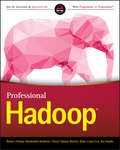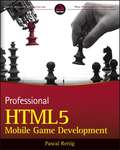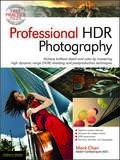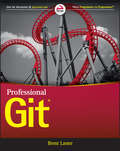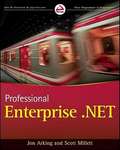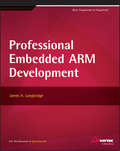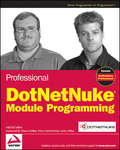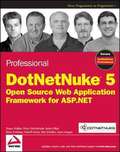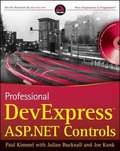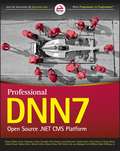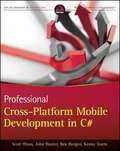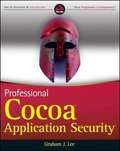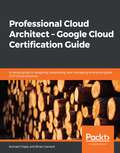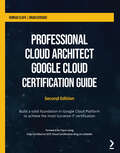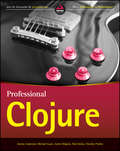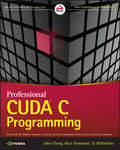- Table View
- List View
Professional JavaScript for Web Developers
by Matt FrisbieUpdate your skill set for ES 6 and 7 with the ultimate JavaScript guide for pros Professional JavaScript for Web Developers is the essential guide to next-level JavaScript development. Written for intermediate-to-advanced programmers, this book jumps right into the technical details to help you clean up your code and become a more sophisticated JavaScript developer. From JavaScript-specific object-oriented programming and inheritance, to combining JavaScript with HTML and other markup languages, expert instruction walks you through the fundamentals and beyond. This new fourth edition has been updated to cover ECMAScript 6 and 7 (also known as ES2015 and ES2016) and the major re-imagination and departure from ES 5.1; new frameworks and libraries, new techniques, new testing tools, and more are explained in detail for the professional developer, with a practical focus that helps you put your new skills to work on real-world projects. The latest—and most dramatic—ES release is already being incorporated into JavaScript engines in major browsers; this, coupled with the rise in mobile web traffic increasing demand for responsive, dynamic web design, means that all web developers need to update their skills—and this book is your ideal resource for quick, relevant guidance. Get up to date with ECMAScript 6 and 7, new frameworks, and new libraries Delve into web animation, emerging APIs, and build systems Test more effectively with mocks, unit tests, functional tests, and other tools Plan your builds for future ES releases Even if you think you know JavaScript, new ES releases bring big changes that will affect the way you work. For a professional-level update that doesn't waste time on coding fundamentals, Professional JavaScript for Web Developers is the ultimate resource to bring you up to speed.
Professional JavaScript for Web Developers
by Matt FrisbieUpdate and upgrade your JavaScript skillset for ES 2023 with the ultimate JavaScript guide for pros Professional JavaScript for Web Developers, 5th edition, is the gold-standard in intermediate-to-advanced JavaScript programming development books. The author dives directly into the inner workings of JavaScript to help you clean up your code and become a more sophisticated and talented JavaScript developer. From object-oriented programming and inheritance to combining JavaScript with HTML and other markup languages, expert computer engineer Matt Frisbie walks you through everything you need to know to level-up your JavaScript game. This new edition is updated to include ECMAScript 2023 and later standard releases, the most useful techniques, and a relentless focus on code that works seamlessly in mobile web browsers and with the latest common frameworks and libraries. With this book, you will: Get up to date with ECMAScript 2023 Get acquainted with the newest frameworks and libraries Explore advanced topics such as web animation, workers, and the latest APIs Get a head start on future ES releases Learn to use modern syntax and best practices Understand how to optimize performance in JavaScript applications Master asynchronous programming patterns using promises, generators, and async/awaitPerfect for those who think they already know JavaScript “pretty well,” Professional JavaScript for Web Developers, 5th edition, is the pro-level update that intermediate and advanced web developers have been waiting for.
Professional Java for Web Applications
by Nicholas S. WilliamsThe comprehensive Wrox guide for creating Java web applications for the enterpriseThis guide shows Java software developers and software engineers how to build complex web applications in an enterprise environment. You'll begin with an introduction to the Java Enterprise Edition and the basic web application, then set up a development application server environment, learn about the tools used in the development process, and explore numerous Java technologies and practices. The book covers industry-standard tools and technologies, specific technologies, and underlying programming concepts.Java is an essential programming language used worldwide for both Android app development and enterprise-level corporate solutionsAs a step-by-step guide or a general reference, this book provides an all-in-one Java development solutionExplains Java Enterprise Edition 7 and the basic web application, how to set up a development application server environment, which tools are needed during the development process, and how to apply various Java technologiesCovers new language features in Java 8, such as Lambda Expressions, and the new Java 8 Date & Time API introduced as part of JSR 310, replacing the legacy Date and Calendar APIsDemonstrates the new, fully-duplex WebSocket web connection technology and its support in Java EE 7, allowing the reader to create rich, truly interactive web applications that can push updated data to the client automaticallyInstructs the reader in the configuration and use of Log4j 2.0, Spring Framework 4 (including Spring Web MVC), Hibernate Validator, RabbitMQ, Hibernate ORM, Spring Data, Hibernate Search, and Spring SecurityCovers application logging, JSR 340 Servlet API 3.1, JSR 245 JavaServer Pages (JSP) 2.3 (including custom tag libraries), JSR 341 Expression Language 3.0, JSR 356 WebSocket API 1.0, JSR 303/349 Bean Validation 1.1, JSR 317/338 Java Persistence API (JPA) 2.1, full-text searching with JPA, RESTful and SOAP web services, Advanced Message Queuing Protocol (AMQP), and OAuthProfessional Java for Web Applications is the complete Wrox guide for software developers who are familiar with Java and who are ready to build high-level enterprise Java web applications.
Professional Java EE Design Patterns
by Murat Yener Alex TheedomMaster Java EE design pattern implementation to improve your design skills and your application's architectureProfessional Java EE Design Patterns is the perfect companion for anyone who wants to work more effectively with Java EE, and the only resource that covers both the theory and application of design patterns in solving real-world problems. The authors guide readers through both the fundamental and advanced features of Java EE 7, presenting patterns throughout, and demonstrating how they are used in day-to-day problem solving.As the most popular programming language in community-driven enterprise software, Java EE provides an API and runtime environment that is a superset of Java SE. Written for the junior and experienced Java EE developer seeking to improve design quality and effectiveness, the book covers areas including:Implementation and problem-solving with design patternsConnection between existing Java SE design patterns and new Java EE conceptsHarnessing the power of Java EE in design patternsIndividually-based focus that fully explores each patternColorful war-stories showing how patterns were used in the field to solve real-life problemsUnlike most Java EE books that simply offer descriptions or recipes, this book drives home the implementation of the pattern to real problems to ensure that the reader learns how the patterns should be used and to be aware of their pitfalls.For the programmer looking for a comprehensive guide that is actually useful in the everyday workflow, Professional Java EE Design Patterns is the definitive resource on the market.
Professional Issues in Software Engineering
by Allison Coleman Diane Rowland Frank BottSoftware engineers are increasingly becoming business people; Professional Issues in Software Engineering, 3rd Edition gives them comprehensive coverage of the issues they should know about. While most books look at programs related to software engineering rather than the context in which they are used, this book covers the major developments that have occured in recent years, such as the Internet, Data Protection Act, and changes to the legal status of software engineers. This updated edition of a successful textbook is for undergraduate and graduate students as well as for professionals in software engineering and computer science.
Professional IronPythonTM
by John Paul MuellerThorough coverage of Microsoft's new dynamic programming language: IronPython IronPython is a powerful and vital part of any . NET developer's toolbox, and although it is several years old, very little literature exists on the topic. This essential resource fills that void and provides you with an in-depth understanding of IronPython. A brief introduction walks you through the installation, usage, and tools of IronPython and also explains what makes IronPython different from other programming languages. Coverage quickly moves on to explaining how to use and work with the IronPython language, and an in-depth look at its environment sheds light on how it can be stand alone or with the . NET Framework. You'll see how IronPython can be used to create either desktop or Web-based applications and you'll witness how it interacts with other existing technologies. In addition, coverage of advanced topics shares techniques for extending IronPython and making it a robust language. Provides you with an in-depth look at IronPython, how it is different from other programming languages, what it is capable of, and how to maximize its potential Explores how IronPython interacts with existing technologies and how it can perform administration tasks Answers popular questions, such as how to extend IronPython and make it a more robust language Tackles topics not addressed anywhere else, including executing IronPython using Mono You'll want to devour every topic covered in Professional IronPython so you can get started working with this powerful programming language today.
Professional IIS 7
by Jeff Cochran Ken Schaefer Scott Forsyth Rob Baugh Mike Everest Dennis GlendenningAs the first update to Microsoft's server operating system in nearly five years, Windows Server 2008 boasts the new Internet Information Services 7. 0 (IIS 7), which is the largest departure from previous versions of IIS ever. Written by an author team that includes four Microsoft MVPs, this book shows you how to take advantage of these exciting new features of IIS 7. With a clear understanding of IIS 7, you'll learn to deploy, install, monitor, manage, and secure an IIS environment with confidence and ease. Note: CD-ROM/DVD and other supplementary materials are not included as part of eBook file.
Professional Heroku Programming
by Chris Kemp Brad GygerA complete guide to building and deploying web apps with HerokuA cloud application platform, Heroku is currently the only approved platform for creating apps within Facebook, and its number of users is growing at rapid pace. However, there are very few books on the market that offer professional-level coverage of this platform, until now. The author duo begins with an introduction to the Heroku platform and its associated core concepts and then goes on to explain how writing for this platform differs from that of traditional development systems. Example applications, additional resources, and advice for your next steps round out this resource, making it a thorough, indispensable guide. Features information not found anywhere else, as both authors work for HerokuExplains the inner workings of Heroku with special emphasis placed on building web and mobile applicationsIntroduces GIT-based development workflow and the process model within the Heroku platformDetails coding, building, deploying, and scaling effectively using the Heroku tool baseProviding you with fully functional code and downloadable code examples, Professional Heroku Programming is your complete guide to mastering this platform.
Professional Hadoop Solutions
by Boris Lublinsky Kevin T. Smith Alexey YakubovichThe go-to guidebook for deploying Big Data solutions with HadoopToday's enterprise architects need to understand how the Hadoop frameworks and APIs fit together, and how they can be integrated to deliver real-world solutions. This book is a practical, detailed guide to building and implementing those solutions, with code-level instruction in the popular Wrox tradition. It covers storing data with HDFS and Hbase, processing data with MapReduce, and automating data processing with Oozie. Hadoop security, running Hadoop with Amazon Web Services, best practices, and automating Hadoop processes in real time are also covered in depth. With in-depth code examples in Java and XML and the latest on recent additions to the Hadoop ecosystem, this complete resource also covers the use of APIs, exposing their inner workings and allowing architects and developers to better leverage and customize them.The ultimate guide for developers, designers, and architects who need to build and deploy Hadoop applicationsCovers storing and processing data with various technologies, automating data processing, Hadoop security, and delivering real-time solutionsIncludes detailed, real-world examples and code-level guidelinesExplains when, why, and how to use these tools effectivelyWritten by a team of Hadoop experts in the programmer-to-programmer Wrox styleProfessional Hadoop Solutions is the reference enterprise architects and developers need to maximize the power of Hadoop.
Professional Hadoop
by Kai Sasaki Benoy Antony Konstantin Boudnik Cheryl Adams Branky Shao Cazen LeeThe professional's one-stop guide to this open-source, Java-based big data framework Professional Hadoop is the complete reference and resource for experienced developers looking to employ Apache Hadoop in real-world settings. Written by an expert team of certified Hadoop developers, committers, and Summit speakers, this book details every key aspect of Hadoop technology to enable optimal processing of large data sets. Designed expressly for the professional developer, this book skips over the basics of database development to get you acquainted with the framework's processes and capabilities right away. The discussion covers each key Hadoop component individually, culminating in a sample application that brings all of the pieces together to illustrate the cooperation and interplay that make Hadoop a major big data solution. Coverage includes everything from storage and security to computing and user experience, with expert guidance on integrating other software and more. Hadoop is quickly reaching significant market usage, and more and more developers are being called upon to develop big data solutions using the Hadoop framework. This book covers the process from beginning to end, providing a crash course for professionals needing to learn and apply Hadoop quickly. Configure storage, UE, and in-memory computing Integrate Hadoop with other programs including Kafka and Storm Master the fundamentals of Apache Big Top and Ignite Build robust data security with expert tips and advice Hadoop's popularity is largely due to its accessibility. Open-source and written in Java, the framework offers almost no barrier to entry for experienced database developers already familiar with the skills and requirements real-world programming entails. Professional Hadoop gives you the practical information and framework-specific skills you need quickly.
Professional HTML5 Mobile Game Development
by Pascal RettigCreate mobile game apps for the lucrative gaming market If you're an experienced developer seeking to break into the sizzling mobile game market, this is the book for you. Covering all mobile and touchscreen devices, including iPhones, iPads, Android, and WP7. 5, this book takes you through the steps of building both single- and multi-player mobile games. Topics include standard patterns for building games in HTML5, what methods to choose for building (CSS3, SVG, or Canvas), popular game engines and frameworks, and much more. Best of all, code for six basic games is provided, so you can modify, further develop, and make it your own. Shows intermediate developers how to develop games in HTML5 and build games for iPhone, iPad, Android, and WP7. 5 mobile and touchscreen devices Explains single-player and multi-player mobile game development Provides code for six basic games in a GitHub repository, so readers can collaborate and develop the code themselves Explores specific APIs to make games even more compelling, including geolocation, audio, and device orientation Reviews three popular open-source HTML5 game engines--crafty. js, easel. js, and enchant. js Covers simple physics as well as using an existing physics library The world is going mobile, as is the game industry. Professional HTML5 Mobile Game Development helps savvy developers join in this exploding market.
Professional HDR Photography
by Mark ChenBuilding on a professional photographer's on-the-job experience using the high dynamic range (HDR) imaging technique, which captures an astounding range of tones that far exceeds the native abilities of any camera, this guide shows serious photographers how a more sophisticated approach to HDR can produce images that lack visual pretense, stand the test of time, and realistically capture details that would otherwise elude the photographer. It demonstrates the basic procedure for creating an HDR image step-by-step, then explores progressively more complex and refined techniques that can be applied as the scene dictates or the artist’s personal aesthetic requires. Ample image sequences with plenty of screen shots let the reader follow the entire process through from start to finish. Unique techniques are presented for the treatment of special subjects, ranging from landscapes to still lifes and portraits. Ultimately, the handbook demonstrates that HDR imaging is a powerful tool and the professional photographers who take the time to fully master its potential can mean substantial rewards, both creatively and financially.
Professional Git
by Brent LasterLeverage the power of Git to smooth out the development cycle Professional Git takes a professional approach to learning this massively popular software development tool, and provides an up-to-date guide for new users. More than just a development manual, this book helps you get into the Git mindset—extensive discussion of corollaries to traditional systems as well as considerations unique to Git help you draw upon existing skills while looking out—and planning for—the differences. Connected labs and exercises are interspersed at key points to reinforce important concepts and deepen your understanding, and a focus on the practical goes beyond technical tutorials to help you integrate the Git model into your real-world workflow. Git greatly simplifies the software development cycle, enabling users to create, use, and switch between versions as easily as you switch between files. This book shows you how to harness that power and flexibility to streamline your development cycle. Understand the basic Git model and overall workflow Learn the Git versions of common source management concepts and commands Track changes, work with branches, and take advantage of Git's full functionality Avoid trip-ups and missteps common to new users Git works with the most popular software development tools and is used by almost all of the major technology companies. More than 40 percent of software developers use it as their primary source control tool, and that number continues to grow; the ability to work effectively with Git is rapidly approaching must-have status, and Professional Git is the comprehensive guide you need to get up to speed quickly.
Professional Enterprise .NET
by Scott Millett Jon ArkingComprehensive coverage to help experienced . NET developers create flexible, extensible enterprise application code If you're an experienced Microsoft . NET developer, you'll find in this book a road map to the latest enterprise development methodologies. It covers the tools you will use in addition to Visual Studio, including Spring. NET and nUnit, and applies to development with ASP. NET, C#, VB, Office (VBA), and database. You will find comprehensive coverage of the tools and practices that professional . NET developers need to master in order to build enterprise more flexible, testable, and extensible . NET applications with minimal upfront costs. Helps C#, VB. Net, and ASP. NET developers who wish to migrate both their applications and their own skillsets to newer, more flexible enterprise methodologies Describes each new pattern or feature along with its benefits, then outlines the pros and cons of its implementation Includes an introduction to enterprise development and a comprehensive overview of the differences between new enterprise patterns and older, traditional Microsoft programming Explains how to implement these patterns by upgrading an existing code base Covers benefits including flexibility, automated testing, extensibility, and separation; modular code; test-driven development, unit test, test automation, and refactoring; inversion of control; and object relational mapping Also covers enterprise design patterns: MVC including Ruby on Rails, Monorail, and ASP. NET MVC, MVP, observer, and more Contains a primer on object-oriented design Professional Enterprise . NET focuses on the often-inevitable compromise between forward-thinking design and the needs of business, helping you build applications that serve both.
Professional Embedded ARM Development
by James A. LangbridgeA practical Wrox guide to ARM programming for mobile devicesWith more than 90 percent of mobile phones sold in recent years using ARM-based processors, developers are eager to master this embedded technology. If you know the basics of C programming, this guide will ease you into the world of embedded ARM technology. With clear explanations of the systems common to all ARM processors and step-by-step instructions for creating an embedded application, it prepares you for this popular specialty. While ARM technology is not new, existing books on the topic predate the current explosive growth of mobile devices using ARM and don't cover these all-important aspects. Newcomers to embedded technology will find this guide approachable and easy to understand.Covers the tools required, assembly and debugging techniques, C optimizations, and moreLists the tools needed for various types of projects and explores the details of the assembly languageExamines the optimizations that can be made to ensure fast code Provides step-by-step instructions for a basic application and shows how to build upon itProfessional Embedded ARM Development prepares you to enter this exciting and in-demand programming field.
Professional DotNetNuke Module Programming
by Shaun Walker Mitchel SellersThis book details the development techniques needed to work within the DotNetNuke framework. It discusses the available methods to extend the framework, as well as the situations and rules governing when each respective extension model should be used. Additionally, the book stresses leveraging the framework in as many areas as possible, and ultimately using the framework to the advantage of the developer. Samples in the book are provided in both C# and Visual Basic (VB), and provides some excellent new features that are supported, starting with DotNetNuke 5.0.
Professional DotNetNuke 5
by Shaun Walker Darrell Hardy Stan Schultes Ryan Morgan Brian ScarbeauDotNetNuke creator Shaun Walker leads this superlative author team of MVPs while delivering the latest update of a bestseller. They offer complete coverage of the major revisions to DotNetNuke 5, such as more granular administration, widgets, XHTML compliance, improved social networking, workflow, and better content management. They thoroughly cover installing, configuring, administering, and developing modules for DotNetNuke. You?ll learn portal and host administration, configuration in a hosted environment, developing and working with modules, designing a DotNetNuke portal with skins, integrating workflow in DotNetNuke, using DotNetNuke social networking tools, and much more.
Professional DevExpressTM ASP.NET Controls
by Paul Kimmel Julian Bucknall Joe KunkLearn to use Devexpress ASP. NET controls, and get $250 worth of controls included with the book Devexpress is a leading supplier of ASP. NET controls - the addins used in ASP. NET sites. Not only does this book show you how to make the most of them with Silverlight and Ajax, reporting, calendars, editors, and charts, but you also get actual controls worth $250 on the CD-ROM included with the book. Regardless of your level of ASP. NET expertise, this complete reference will show you how to implement many award-winning and useful controls into your ASP. NET applications. Controls save time and effort as well as adding functionality, and this book helps you take full advantage of what they offer. Devexpress is a leading vendor for ASP. NET controls that developers can use to add features, accomplish difficult tasks, and save development and testing time This book addresses the all-important use of controls for Silverlight and Ajax, as well as classic essentials like reporting, editors, calendars, and charts Covered controls include reports and charts, HTML editors, menus and treeviews, gridview, and many more Explains when and where to use controls and how to add functionality without additional development CD-ROM includes $250 worth of Devexpress controls ready for you to use right away With Professional DevExpress ASP. NET Controls, you'll be a step ahead in developing powerful ASP. NET applications. Note: CD-ROM/DVD and other supplementary materials are not included as part of eBook file.
Professional DNN7
by Scott Willhite Chris Paterra Shaun Walker Mitchel Sellers Peter Donker Israel Martinez Bruce Chapman Will Strohl Cathal Connolly Nathan Rover Erik Van Ballegoij Ralph Williams Jr. Charles Nurse Ashish Prasad Clinton Bland Dennis Shiaothe core of the DNN solution. All of these enhancements provide developers with a lot of power in one solution.In previous Professional DotNetNuke books, DotNetNuke founder Shaun Walker authored a popular introductory chapter covering the evolution of the DNN open source project. He will expand this initial chapter with information about venture capital funding, commercialization, and software business insights - which will be of interest to DNN enthusiasts as well as technology entrepreneurs.DNN site builders, administrators, and developers will learn how to:determine if they have met the installation requirments and install DNNadminister and host a DNN site and install and configure modulesmanage users and keep a DNN installation securelocalize a DNN site for multiple languagesbuild custom DNN modules in C# using the model of separation of database, business logic, and presentation layerscustomize the DNN look with skinningmake their site social with EVOQ
Professional Cross-Platform Mobile Development in C#
by John Hunter Kenny Goers Scott Olson Ben HorgenDevelop mobile enterprise applications in a language you already know!With employees, rather than the IT department, now driving the decision of which devices to use on the job, many companies are scrambling to integrate enterprise applications. Fortunately, enterprise developers can now create apps for all major mobile devices using C#/.NET and Mono, languages most already know. A team of authors draws on their vast experiences to teach you how to create cross-platform mobile applications, while delivering the same functionality to PC's, laptops and the web from a single technology platform and code-base. Rather than reinventing the wheel with each app, this book provides you with the tools you need for cross-platform development--no new languages needed!Presents an overview of the sea change occurring with the use of enterprise mobile applications and what it means for developersShares the criteria for evaluating and selecting the best option for application architectureReviews tools and techniques for setting up a cross-platform development environmentOffers an introduction to the MonoCross open-source project and pattern for cross-platform developmentPacked with specific software design patterns, development best practices, code examples and sample applications, this must-have book gets you started developing cross-platform mobile apps today.
Professional Cocoa Application Security
by Graham J. LeeThe first comprehensive security resource for Mac and iPhone developersThe Mac platform is legendary for security, but consequently, Apple developers have little appropriate security information available to help them assure that their applications are equally secure. This Wrox guide provides the first comprehensive go-to resource for Apple developers on the available frameworks and features that support secure application development.While Macs are noted for security, developers still need to design applications for the Mac and the iPhone with security in mind; this guide offers the first comprehensive reference to Apple's application security frameworks and featuresShows developers how to consider security throughout the lifecycle of a Cocoa application, including how Mac and iPhone security features work and how to leverage themDescribes how to design, implement, and deploy secure Mac and iPhone software, covering how user configurations affect application security, the keychain feature, how to maximize filesystem security, how to write secure code, and much moreProfessional Cocoa Application Security arms Apple developers with essential information to help them create Mac and iPhone applications as secure as the operating system they run on.
Professional Cloud Architect – Google Cloud Certification Guide: A handy guide to designing, developing, and managing enterprise-grade GCP cloud solutions
by Konrad Clapa Brian GerrardBecome a Professional Cloud Architect by exploring essential concepts, tools, and services in GCP and working through tests designed to help you get certified Key Features Plan and design a GCP cloud solution architecture Ensure the security and reliability of your cloud solutions and operations Test yourself by taking mock tests with up-to-date exam questions Book Description Google Cloud Platform (GCP) is one of the leading cloud service suites and offers solutions for storage, analytics, big data, machine learning, and application development. It features an array of services that can help organizations to get the best out of their infrastructure. This comprehensive guide covers a variety of topics specific to Google's Professional Cloud Architect official exam syllabus and guides you in using the right methods for effective use of GCP services. You'll start by exploring GCP, understanding the benefits of becoming a certified architect, and learning how to register for the exam. You'll then delve into the core services that GCP offers such as computing, storage, and security. As you advance, this GCP book will help you get up to speed with methods to scale and automate your cloud infrastructure and delve into containers and services. In the concluding chapters, you'll discover security best practices and even gain insights into designing applications with GCP services and monitoring your infrastructure as a GCP architect. By the end of this book, you will be well versed in all the topics required to pass Google's Professional Cloud Architect exam and use GCP services effectively. What you will learn Manage your GCP infrastructure with Google Cloud management options such as CloudShell and SDK Understand the use cases for different storage options Design a solution with security and compliance in mind Monitor GCP compute options Discover machine learning and the different machine learning models offered by GCP Understand what services need to be used when planning and designing your architecture Who this book is for If you are a cloud architect, cloud engineer, administrator, or any IT professional who wants to learn how to implement Google Cloud services in your organization and become a GCP Certified Professional Cloud Architect, this book is for you. Basic knowledge of server infrastructure, including Linux and Windows Servers, is assumed. Knowledge of network and storage will also be helpful.
Professional Cloud Architect Google Cloud Certification Guide: Build a solid foundation in Google Cloud Platform to achieve the most lucrative IT certification, 2nd Edition
by Konrad Clapa Brian Gerrard Yujun LiangBecome a Professional Cloud Architect by exploring the essential concepts, tools, and services in GCP and working through practice tests designed to help you take the exam confidentlyKey FeaturesPlan and design a GCP cloud solution architectureEnsure the security and reliability of your cloud solutions and operationsAssess your knowledge by taking mock tests with up-to-date exam questionsBook DescriptionGoogle Cloud Platform (GCP) is one of the industry leaders thanks to its array of services that can be leveraged by organizations to bring the best out of their infrastructure. This book is a comprehensive guide for learning methods to effectively utilize GCP services and help you become acquainted with the topics required to pass Google's Professional Cloud Architect certification exam. Following the Professional Cloud Architect's official exam syllabus, you'll first be introduced to the GCP. The book then covers the core services that GCP offers, such as computing and storage, and takes you through effective methods of scaling and automating your cloud infrastructure. As you progress through the chapters, you'll get to grips with containers and services and discover best practices related to the design and process. This revised second edition features new topics such as Cloud Run, Anthos, Data Fusion, Composer, and Data Catalog. By the end of this book, you'll have gained the knowledge required to take and pass the Google Cloud Certification – Professional Cloud Architect exam and become an expert in GCP services.What you will learnUnderstand the benefits of being a Google Certified Professional Cloud ArchitectFind out how to enroll for the Professional Cloud Architect examMaster the compute options in GCPExplore security and networking options in GCPGet to grips with managing and monitoring your workloads in GCPUnderstand storage, big data, and machine learning servicesBecome familiar with exam scenarios and passing strategiesWho this book is forIf you are a cloud architect, cloud engineer, administrator, or any IT professional looking to learn how to implement Google Cloud services in your organization and become a GCP Certified Professional Cloud Architect, this book is for you. Basic knowledge of server infrastructure, including Linux and Windows Servers, is assumed. A solid understanding of network and storage will help you to make the most out of this book.
Professional Clojure
by Nick Bailey Jeremy Anderson Michael Gaare Justin Holguín Timothy PratleyClear, practical Clojure for the professional programmer Professional Clojure is the experienced developer's guide to functional programming using the Clojure language. Designed specifically to meet the needs of professional developers, this book briefly introduces functional programming before skipping directly to the heart of using Clojure in a real-world setting. The discussion details the read—eval—print workflow that enables fast feedback loops, then dives into enterprise-level Clojure development with expert guidance on web services, testing, datomics, performance, and more. Read from beginning to end, this book serves as a clear, direct guide to Clojure programming—but the comprehensive coverage and detail makes it extraordinarily useful as a quick reference for mid-project snags. The author team includes four professional Clojure developers, ensuring professional-level instruction from a highly practical perspective. Clojure is an open-source programming language maintained and supported by Cognitect., and quickly gaining use across industries at companies like Amazon, Walmart, Facebook, Netflix, and more. This guide provides a concise, yet thorough resource for professional developers needing to quickly put Clojure to work. Parse the difference between functional and object-oriented programming Understand Clojure performance and capabilities Develop reactive web pages using ClojureScript Adopt an REPL-driven development workflow Clojure is a modern dialect of Lisp, designed for concurrency and Java compatibility. It can be used with the Java virtual machine, Microsoft's Common Language Runtime, and JavaScript engines, providing a level of both versatility and functionality that is appealing to more and more enterprise-level developers. As requirements grow increasingly complex, stepping away from imperative programming can dramatically streamline the development workflow. Professional Clojure provides the expert instruction that gets professionals up to speed and back to work quickly.
Professional CUDA C Programming
by John Cheng Max Grossman Ty MckercherBreak into the powerful world of parallel GPU programming with this down-to-earth, practical guideDesigned for professionals across multiple industrial sectors, Professional CUDA C Programming presents CUDA -- a parallel computing platform and programming model designed to ease the development of GPU programming -- fundamentals in an easy-to-follow format, and teaches readers how to think in parallel and implement parallel algorithms on GPUs. Each chapter covers a specific topic, and includes workable examples that demonstrate the development process, allowing readers to explore both the "hard" and "soft" aspects of GPU programming.Computing architectures are experiencing a fundamental shift toward scalable parallel computing motivated by application requirements in industry and science. This book demonstrates the challenges of efficiently utilizing compute resources at peak performance, presents modern techniques for tackling these challenges, while increasing accessibility for professionals who are not necessarily parallel programming experts. The CUDA programming model and tools empower developers to write high-performance applications on a scalable, parallel computing platform: the GPU. However, CUDA itself can be difficult to learn without extensive programming experience. Recognized CUDA authorities John Cheng, Max Grossman, and Ty McKercher guide readers through essential GPU programming skills and best practices in Professional CUDA C Programming, including:CUDA Programming ModelGPU Execution ModelGPU Memory modelStreams, Event and ConcurrencyMulti-GPU ProgrammingCUDA Domain-Specific LibrariesProfiling and Performance TuningThe book makes complex CUDA concepts easy to understand for anyone with knowledge of basic software development with exercises designed to be both readable and high-performance. For the professional seeking entrance to parallel computing and the high-performance computing community, Professional CUDA C Programming is an invaluable resource, with the most current information available on the market.
